When the Americans left the room the Europeans took over.
They call it EuroTok, WorldTok and GlobalTok. Users from countries like Scotland, Germany, France, Sweden and Norway are absolutely giddy that the US TikTok ban edged out the loudest, gaudiest content hogs, finally giving everybody else enough space to populate the app with voices from other parts of the world.
“You know what this reminds me of . . . the non-USTok, but especially EuroTok, having been exposed to it for a few days?” Veronica Toumanova asked in a video she made from Paris. “It’s like having left a very tumultuous, trauma-bonded relationship with a lot of drama, a lot of passion, a lot of ups and downs and maybe some narcissistic abuse, codependency, emotional roller coaster, and suddenly finding yourself in a healthy relationship where people are peaceful and calm and friendly and gentle and not looking for drama, enjoying the simple small things of life.
“ ‘Look, there is a forest covered in snow in Sweden.’ ‘Look, there is a cat in Norway.’ ‘Look, I’m having my morning coffee.’ ”
The US government banned TikTok on Jan. 19 due to concerns that its Chinese owners use it to collect data. President Trump — who, ironically, first proposed a ban in 2020 — signed an executive order on his inauguration day putting the law to ban it on a 75-day hold. The app is operational in the US, but it is not available from Google or iPhone stores.* I deleted my US account and, thanks to my French residency, opened a French one. My feed completely transformed.
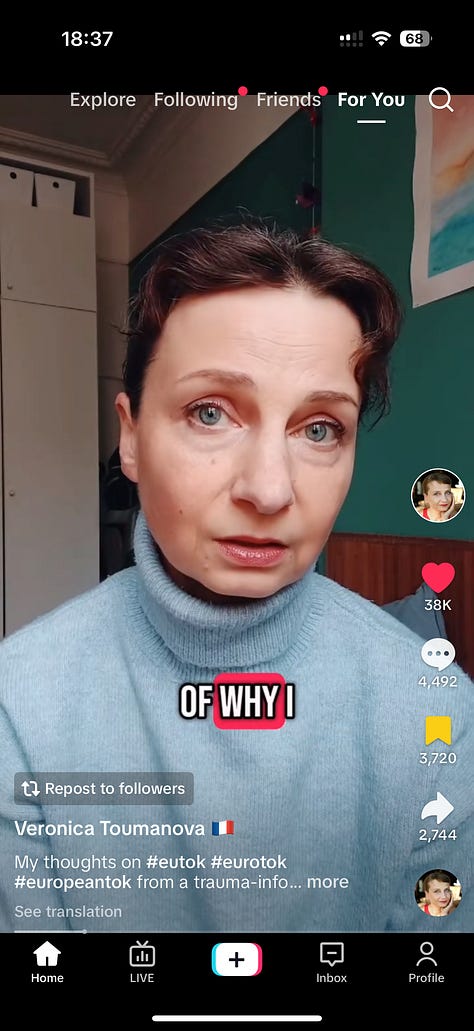
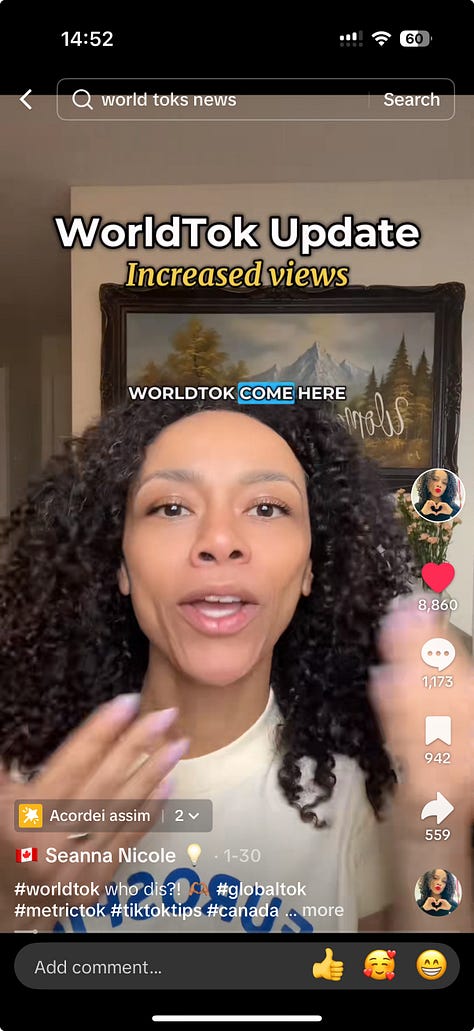
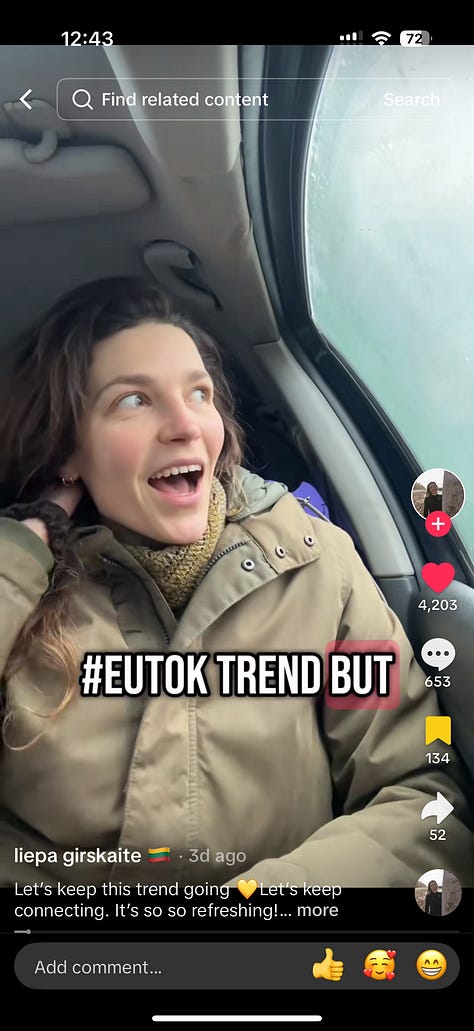
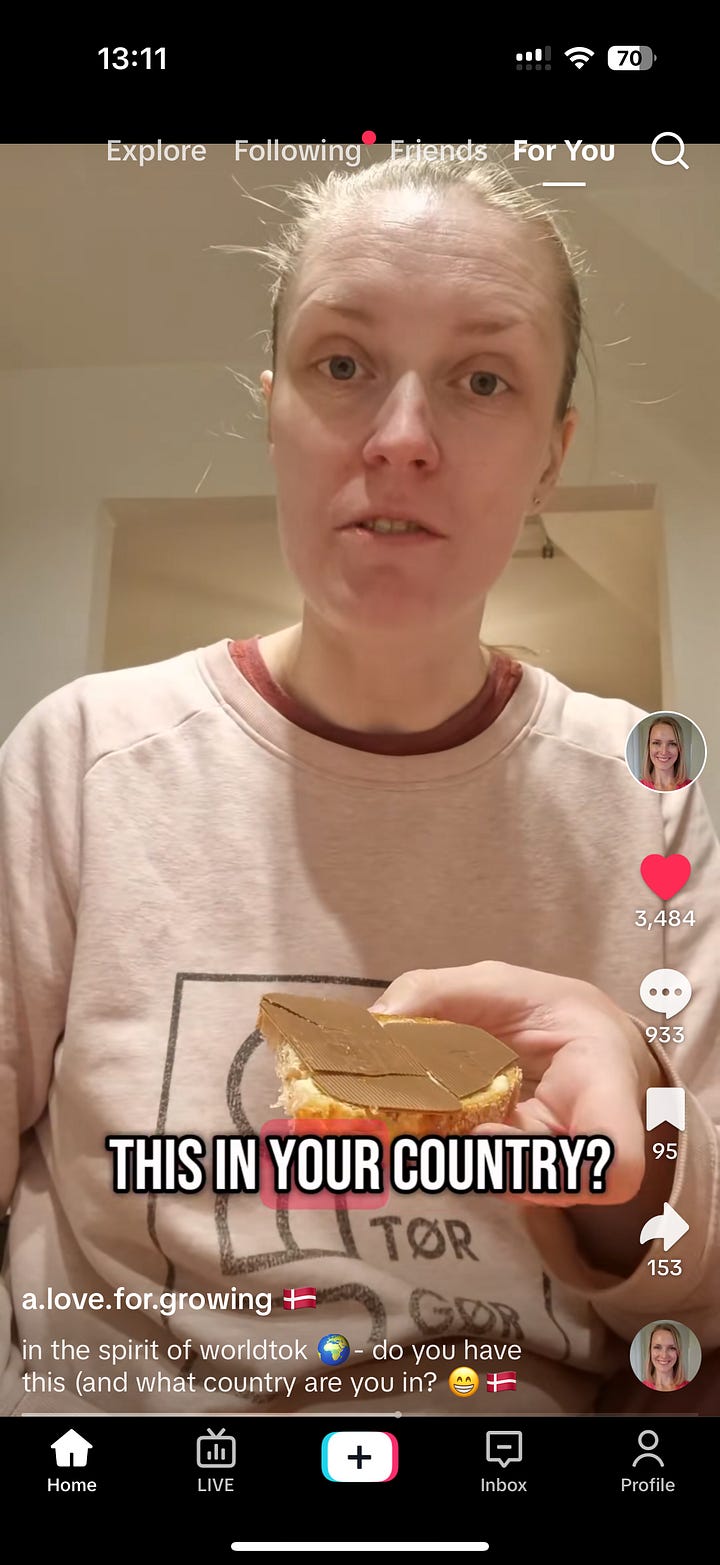
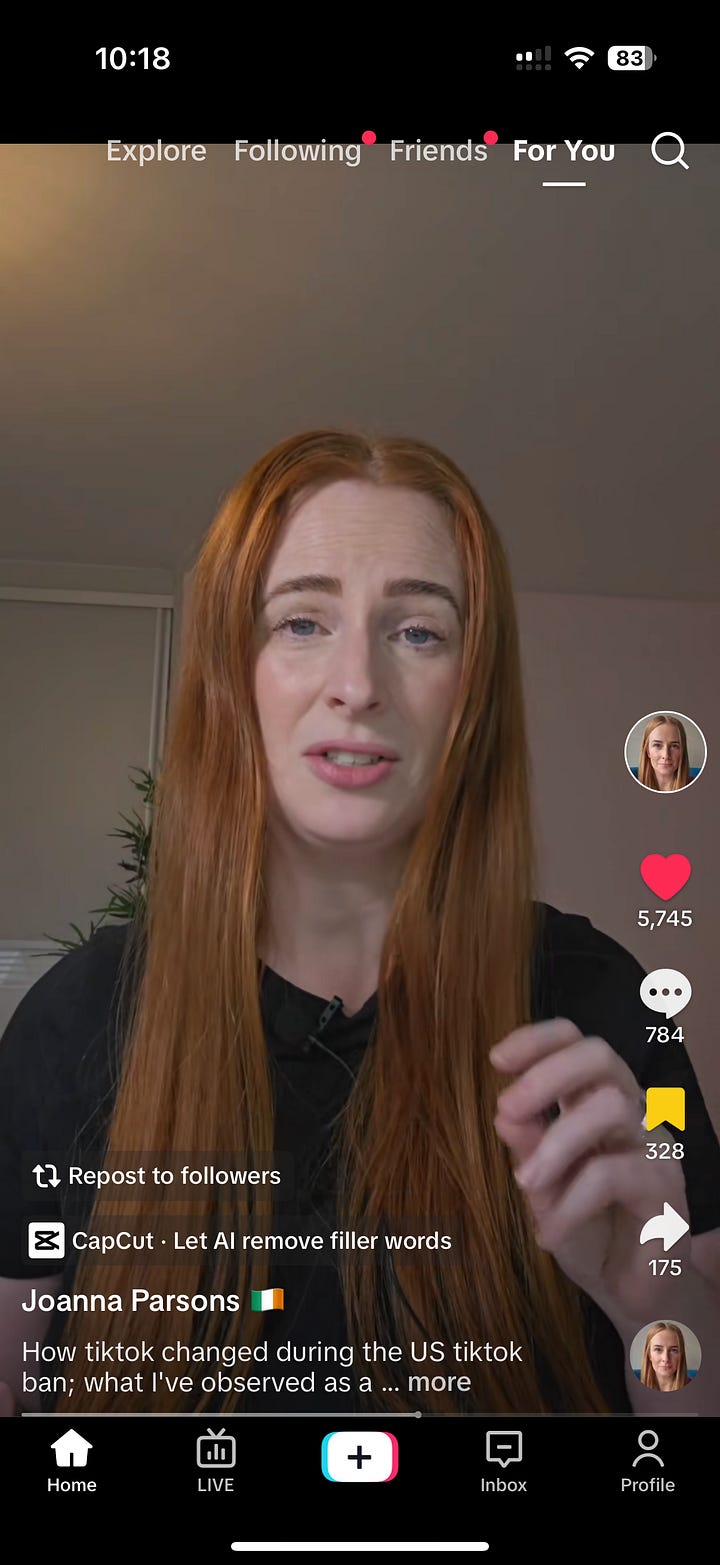
Before the ban my page was routinely populated by typical American content. There was this guy in short shorts, with an enormous penis, chirping and whistling to herd baby chicks on his carpeted hallway, all the while pretending the point was the chicks, and not showing off his dick. I often saw a young woman shoving overstuffed Chipotle burritos and Baja Blast into her mouth while orange sauce dribbled from her lips. White people of all ages were constantly yelling at innocent black people who dared to park on their street. There was a woman with a thick Boston accent and way, way too much makeup who would yell things like, “Get Ready With Me To Go to Korea!” She was both adored and reviled, especially after that time she credited her long eyelashes to a certain mascara, only to have a bunch of fans accuse her of wearing false lashes.
There were just so many GRWM (get ready with me) videos, such a glut of muckbangs (people eating disgustingly huge quantities of fast food in front of the camera), makeup tutorials, weird recipes using whole blocks of cheddar cheese, people arguing with Trumpers, and doctors popping pimples. What began as a place to record yourself dancing had become loud, often gross, sometimes hilarious, and – of course, because America – curated to make a buck. It was like a 24-hour episode of The Housewives of The United States of America, all yelling at the manager at the same time.
Every once in a while I’d come across a French person offering all the different ways to say “I’m tired” in French, or Bunny the dog “talking” to her owner by using voice buttons on the floor. Invariably, though, the guy with the baby chicks would break through. Even my sweet visits with Cecilia who, “lives on Svalbard, an Island close to the North Pole,” had become muscled out by all the makeup lessons, forcing me to switch over to YouTube to see her romp through Polar Nights with her dog Grim.
Now I see EU parliament members discussing world affairs, dogs going for walks with their moms in the Netherlands, Scotsmen with swoon-worthy accents guiding quiet tours of breathtaking landscapes, and a lot of world citizens stretching their arms wide in their new US-free zone and talking about the nicest stuff. Speaking of nice stuff, did you know that in Denmark they have these super thin slivers of chocolate made specifically to put on top of a slice of bread with butter? Isn’t it marvelous?
Many of the soft-spoken testimonials from non-Americans mentioned how much their mental health has improved since they stopped seeing US influencers. I have felt that, too. In fact, I wasn’t even aware before WorldTok that it’s possible to have kind, gentle comment sections without snark and contempt.
“I cannot get over this. It is so nice to see all these European creators, all these European business owners, start speaking in English and actually sharing what they’re doing with our part of the world,” said Liepa Girskaite, from Lithuania.
Damekort, from Norway, described the new atmosphere as making her feel, “like I’m at home now and just not being bombarded with hate comments, like, all the time. It’s just such a friendly place now. I’ve been going through and liking every single video I see that has the flags on it. The acceptable flags, I mean.”
Laurence.paq, a Canadian living in Denmark, said in a video that she was relieved to see that videos on WorldTok lacked the common “viral hooks” that Americans often use: “There is no, ‘Here’s what you need to know’ about something, or, ‘If you’re struggling with this, do this,’ or, ‘I was today years old when...’ It is so nice to just see regular people living their regular life without needing a viral hook to make people watch them.”
Influencers use those hooks to rack up enough views to earn them paid partnerships and brand deals. I’ve seen several nascent TikTokers employ these tactics to grow rich enough to buy ostentatious houses or rent spectacular apartments in Paris. One famous TikToker even rented a second house just to make her videos. The Boston makeup girl has a room in her new house just for her makeup. It’s at least twice the size of my bedroom.
A woman who describes herself as, “Obsessed With This Life” and lives in England, listed all the new types of videos that had broken through to her page: “This morning, having my breakfast, I already watched something about baroque architecture in Austria, something about owls in Scotland, something about sledging in Sweden, something wonderful, absolutely wonderful, about frozen rivers and national costumes in Iceland. . .”
Joanna Parsons, a communications consultant in Ireland, said that TikTok had become much nicer since the change.
"When the US creators were absent, the whole energy on the platform changed,” Parsons said. “I did hear one creator describe it like this: It was as if you were at a party and all the extroverts left and all the introverts could finally relax and just speak quietly and just chat with each other without any pressure.”
Indeed. Now that the ones taking up all the space and making all the noise aren’t popping up, people outside of the US get to speak to each other about their everyday lives and learn about everyday lives in other countries. Some have admitted stepping out of their comfort zone to make their first videos in English, their common language.
This isn’t to say that the Europeans hate the Americans. “We noticed a difference,” said Brian Smith, a model train enthusiast from the UK. “We love America but this transcends that.”
I admit that, at first, I was bummed to miss the constant speculation over why Danae and Mandie split up, but that regret was quickly overtaken by an newly-acquired smugness that I, too – enabled by my French carte de sejour – have moved past American TikTok and earned the right to hang out with pithy members of the EU Parliament, in the snow-covered forest in Sweden, with a cat from Norway.
Just today I saw a guy in the UK start his video by saying, “Are you here for the Medieval church doors?” Yes! Yes I am!
*TikTok is now available on App stores.





My favorite part is that the First Felon banned it dude to concerns about China collecting data on US citizens. That said, I’m not on it but I get sent stuff that is often unbelievably stupid. Give me a Scandinavian forest or timelapse of croissants cooking any time!
Have never watched or joined TikTok for all the negative reasons you mention. Maybe when I get to France I'll try WorldTok. Thanks for the review & info.